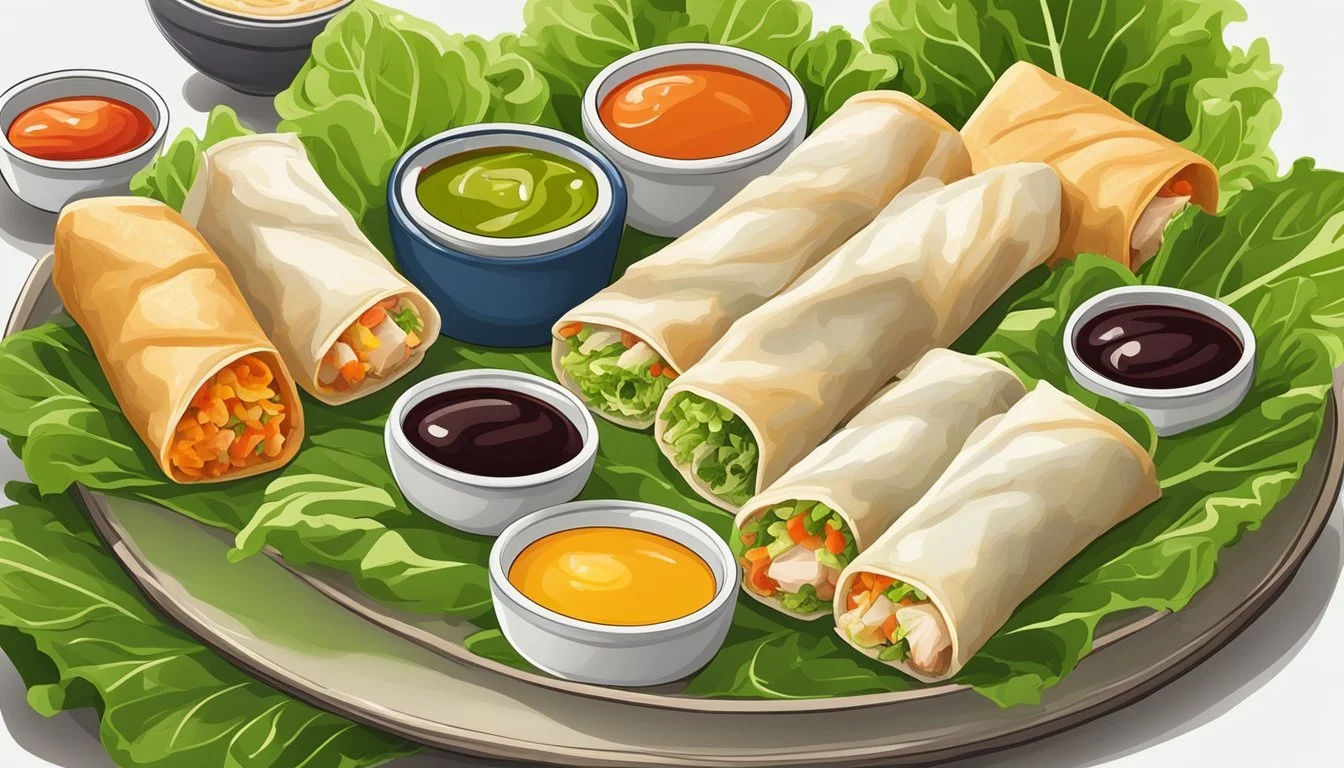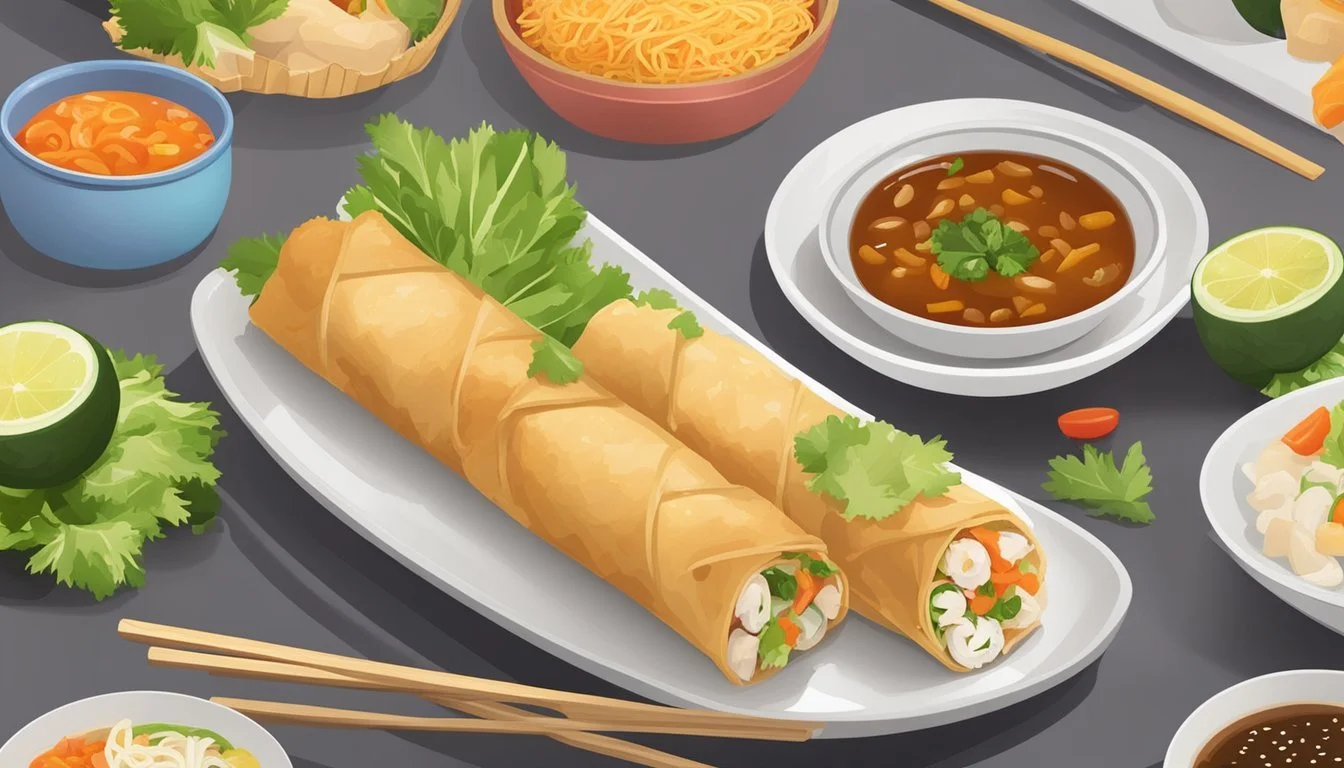How Long Do Chicken and Vegetable Spring Rolls Last?
Shelf Life and Storage Tips
Spring rolls, especially chicken and vegetable varieties, are a popular appetizer and snack choice. Their shelf life varies based on how they are stored. When left at room temperature, spring rolls generally last only 1-2 hours before the quality starts to decline.
Refrigeration can extend their freshness. Wrapping each spring roll individually in plastic, placing them in a single layer, and covering with a damp paper towel can help. In the fridge, properly stored spring rolls can remain fresh for up to 24 hours, though some sources suggest a shorter period, around 3-4 hours.
It's essential to keep the fridge temperature below 40°F (4°C) to ensure the spring rolls stay safe to eat. Keeping this in mind will help you enjoy these delightful snacks without worrying about spoilage.
Understanding Spring Rolls
Spring rolls are a versatile dish enjoyed worldwide, with variations in ingredients and methods of preparation. This section will explore the composition and varieties of spring rolls, their nutritional profile, and popular types.
Composition and Varieties
Spring rolls consist of a thin wrapper filled with ingredients such as fresh vegetables, protein (like chicken, shrimp, or tofu), and rice noodles. The wrappers can be made from rice paper, wheat flour, or other materials.
Fresh spring rolls are often uncooked, showcasing a mix of lettuce, carrots, bell peppers, and other crisp vegetables. Fried spring rolls, or egg rolls, provide a contrasting texture with their crispy wrappers. Vegetarian options are also popular, focusing on mushrooms, cabbage, and tofu.
Nutritional Profile
The nutritional content of spring rolls varies based on ingredients and preparation methods. Fresh spring rolls generally offer a healthy option with lower calories due to an abundance of vegetables such as cabbage, carrots, and lettuce.
Protein sources in spring rolls include chicken, shrimp, or tofu, contributing essential nutrients. The use of rice noodles and fresh vegetables supports a balanced diet by providing fiber and vitamins. Fried spring rolls contain more calories and fats due to the frying process but can still be enjoyed in moderation.
Popular Types of Spring Rolls
Several types of spring rolls are cherished globally, each with unique characteristics:
Vietnamese Fresh Spring Rolls (Goi Cuon): Delicate rice paper wrappers enveloping shrimp, herbs, and fresh vegetables, often served with peanut dipping sauce.
Chinese Egg Rolls: Crispy wheat flour wrappers filled with cabbage, pork, or chicken, accompanied by a savory dipping sauce.
Thai Spring Rolls: A mixture of vegetables, glass noodles, and sometimes meat, wrapped in rice paper and served with a sweet chili sauce.
Filipino Lumpia: Smaller, tightly rolled spring rolls typically filled with ground pork and vegetables, fried until crisp.
Each type reflects the culinary traditions of its region, showcasing diverse fillings and preparation styles.
Preparation and Usage
Preparing and using chicken and vegetable spring rolls requires attention to cooking methods and serving strategies. Focus on frying techniques and pairing options to ensure a delicious experience.
Cooking Techniques
There are multiple ways to cook chicken and vegetable spring rolls to achieve different textures. Deep frying is a popular method that delivers a crispy, golden-brown exterior. To deep fry, heat oil in a deep pan until it reaches 350°F (175°C). Carefully place the spring rolls in the hot oil and fry for 3-5 minutes until they are crispy.
For a healthier option, baking can be employed. Preheat the oven to 400°F (200°C). Arrange the rolls on a baking sheet lined with parchment paper and lightly brush with oil. Bake for 15-20 minutes, turning halfway through, until the rolls are golden and crispy.
Another method is pan frying, which uses less oil. Heat a few tablespoons of oil in a pan over medium heat. Place the spring rolls in the pan and cook for about 2-3 minutes on each side until they are browned and crunchy.
Serving Suggestions
Serving spring rolls with delicious sauces enhances the flavor. Peanut dipping sauce, soy sauce, and sriracha sauce are excellent options. Arrange the spring rolls on a plate with fresh herbs like mint leaves and cilantro to add a refreshing touch.
For appetizers at parties, present the spring rolls with a variety of dipping sauces and small ketchup bowls. Pair them with fresh veggies like carrots and cucumbers to provide a balance of textures and flavors. Each roll can be cut in half for easier handling and consumption.
These techniques and suggestions ensure that your chicken and vegetable spring rolls are a hit, whether crispy or chewy, satisfying every taste preference.
Storage and Preservation
Chicken and vegetable spring rolls can last varying lengths of time based on how they are stored. Short-term storage involves refrigeration, while long-term storage requires freezing.
Short-Term Storage
For short-term storage, refrigerate chicken and vegetable spring rolls.
Wrap each roll individually in plastic wrap to prevent them from drying out. Place the wrapped rolls in a single layer inside an airtight container.
Cover the top with a damp paper towel to maintain moisture levels. Ensure the refrigerator temperature is set below 40°F (4°C). Spring rolls can safely stay fresh for up to 24 hours in the fridge.
Before serving, allow them to sit at room temperature for 15 minutes to enhance the flavors.
Long-Term Storage
For long-term storage, freezing is required.
Individually wrap each spring roll tightly with cling wrap or aluminum foil. Place them in a freezer-safe airtight container to prevent freezer burn and flavor loss.
Label the container with the date of storage. Set your freezer at or below 0°F (-18°C). Frozen spring rolls can last for up to 1-2 months.
Defrost the frozen rolls in the fridge overnight before reheating. Ensure they reach an internal temperature of 165°F (74°C) before consumption.
Shelf Life Determinants
The shelf life of chicken and vegetable spring rolls is influenced by various factors including the type of ingredients used, storage methods, and signs indicating spoilage.
Factors Affecting Freshness
Several factors affect the freshness of chicken and vegetable spring rolls. Ingredients play a key role; fresh veggies and cooked meats tend to spoil faster due to their water content and perishable nature. Temperature is crucial; spring rolls kept at room temperature generally last only 1-2 hours, while refrigeration can extend their freshness to about 4 hours. Proper storage is vital; using cling wrap or an airtight container can help maintain their firmness and prevent them from becoming mushy or bad.
Signs of Spoilage
Recognizing spoilage is essential to avoid consuming bad spring rolls. Smell is often the first indicator; if they emit a sour or off odor, they should not be consumed. Texture changes, such as becoming overly mushy or losing firmness, are also signs of spoilage. Appearance is another clue; discolored veggies or a slimy texture indicate that the spring rolls are no longer fresh. Finally, alterations in taste suggest spoilage, so if the flavor is off, it's best to discard the spring rolls.
Maximizing Freshness
To maximize the freshness of spring rolls, it is important to follow effective storage practices. Keep the rolls in an airtight container or tightly wrapped in cling wrap to reduce exposure to air. Store them at a temperature below 40°F (4°C) in the refrigerator. Consider placing the spring rolls on a layer of paper towels inside the container to absorb excess moisture. Lastly, consuming the rolls within the recommended time frame—generally within a few hours if at room temperature, or within 4 hours if refrigerated—ensures they are enjoyed while still fresh and safe to eat.
Special Considerations
While chicken and vegetable spring rolls are a delightful and versatile dish, several factors need attention to cater to various dietary needs and avoid allergens.
Allergens and Dietary Restrictions
Chicken and vegetable spring rolls can contain common allergens like soy sauce and peanut dipping sauce. Soy sauce, often used as a condiment, can trigger reactions in those with soy allergies. Peanut dipping sauce is another potential allergen to be mindful of.
Shellfish is sometimes included in these rolls; those with shellfish allergies should verify ingredients. Gluten is prevalent in traditional spring roll wrappers and soy sauce; gluten-free alternatives are necessary for those with celiac disease. Monitoring every ingredient and preparing separately can prevent cross-contamination.
Adapting Recipes for Dietary Needs
Modifying recipes to suit dietary needs is essential. Vegetarians can replace chicken with tofu or more veggies. For a gluten-free option, substitute regular wrappers with rice paper and use tamari instead of soy sauce.
Peanut dipping sauce can be swapped for a nut-free alternative, like sunflower seed butter mixed with coconut aminos. Careful ingredient selection ensures safe and inclusive spring rolls for everyone.
Final Thoughts
Chicken and vegetable spring rolls are at their best when enjoyed fresh, offering a delightful combination of taste and texture. Proper storage is essential to maintain these qualities.
Refrigeration: If planning to eat within 24 hours, wrap each roll individually in plastic, place in a single layer, cover with a damp paper towel, and store in an airtight container. Refrigerator temperature should be below 40°F (4°C).
Leftovers: When stored properly in the fridge, spring rolls can retain good quality for up to 24 hours. Beyond this, the texture may become soggy, and the taste may deteriorate.
Freezing: For long-term storage, freezing is recommended. Spring rolls can last up to six months if wrapped tightly and protected against freezer burn.
Reheating Tips: To reheat, avoid microwaving as it may affect the texture. Instead, use an oven or a toaster oven to ensure they remain crispy.
Maintaining the freshness of spring rolls involves careful storage and handling to preserve their delectable taste and texture.






